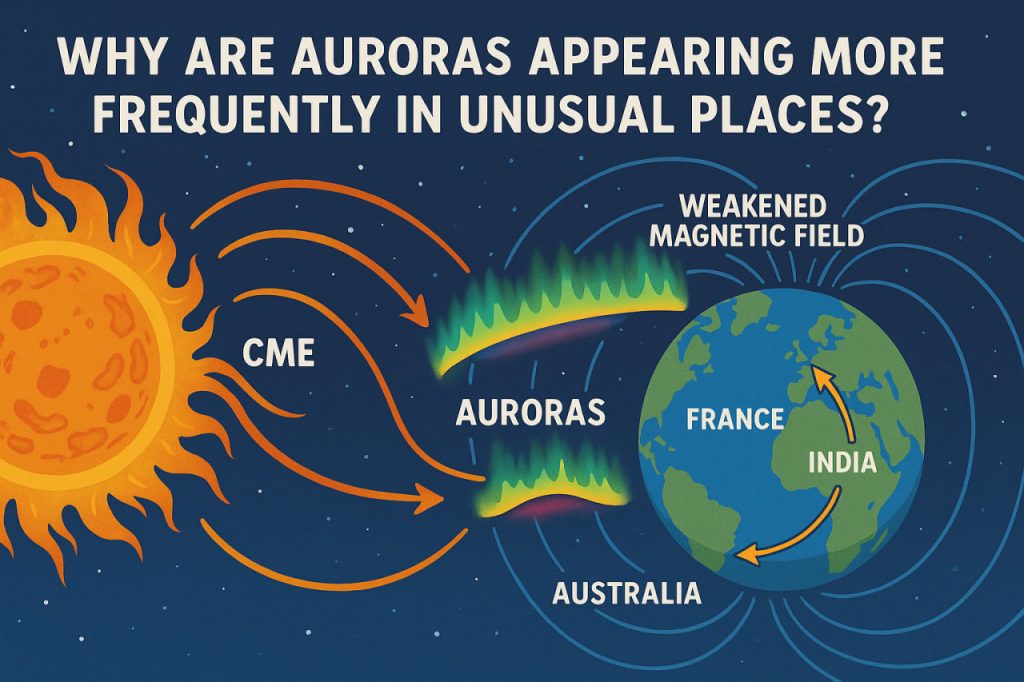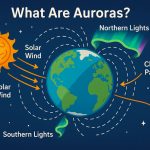In recent years, auroras—usually visible only near the polar regions—have been spotted in unusual areas such as Central Europe, the continental United States, and even parts of northern Africa and Australia. These mesmerizing lights have fascinated many, but their sudden frequency and reach raise a scientific question: what’s causing this shift?
The Sun’s Role: Rising Solar Activity
The primary factor is the Sun’s increasing activity as it approaches the peak of its 11-year solar cycle (Solar Cycle 25).
- The Sun is currently producing more sunspots, solar flares, and coronal mass ejections (CMEs).
- These events send charged particles into space, which, when interacting with Earth’s magnetic field, create auroras.
- During particularly strong geomagnetic storms, the aurora zones stretch farther from the poles and become visible at lower latitudes.
The Expanding Reach of Auroras
Under normal conditions, Earth’s magnetic field directs solar particles toward the poles. However:
- Intense solar storms disturb the magnetosphere, pushing the auroral oval farther toward the equator.
- This results in auroras over areas like Italy, France, Colorado, India, and even southern Australia, where they’re normally rare.
A New Factor: Weakening of Earth’s Magnetic Field
Recent research shows that Earth’s magnetic field is gradually weakening, particularly over a region called the South Atlantic Anomaly.
- A weaker magnetic field allows solar particles to penetrate deeper into Earth’s atmosphere.
- This increases the likelihood of visible auroras at lower latitudes.
- Scientists aren’t certain why the field is weakening, but it may relate to natural shifts in the Earth’s outer core, where the magnetic field is generated.
This weakening doesn’t just allow more auroras—it may also make Earth more vulnerable to solar storms, which can affect satellites and communications.
Solar Cycle 25: What to Expect
Solar Cycle 25 began in 2019 and is expected to peak around 2025–2026.
- Forecasts suggest it will be stronger than previously expected, meaning more powerful solar storms and more widespread auroras.
- This increased activity, combined with a weakening magnetic field, means auroras may become a more common sight even outside traditional viewing zones.
Auroras Are More Than Just Light Shows
Stronger and more frequent auroras are often a sign of intense space weather, which can:
- Disrupt radio and GPS systems
- Affect power grids and satellite function
- Complicate aviation and space missions
So while these glowing skies are beautiful, they’re also indicators of larger space-weather events that can affect daily life and technology.
What’s Not Causing It: Climate Change
It’s important to clarify: the increase in auroras has nothing to do with climate change. Auroras are caused by solar wind and Earth’s magnetic field, not by weather or global temperature changes.
Conclusion
The growing number of auroras seen in unexpected places is the result of a more active Sun and a weakened magnetic field. As solar activity continues to rise and Earth’s magnetic shield changes, we’re likely to witness more auroras at lower latitudes. While these events provide stunning skies, they also remind us of our planet’s delicate relationship with the forces of space.
Glossary
- Solar Cycle: An 11-year pattern of rising and falling solar activity
- Coronal Mass Ejection (CME): A massive burst of plasma from the Sun
- Magnetosphere: Earth’s magnetic shield against solar particles
- Auroral Oval: The ring-like zone where auroras usually appear
- South Atlantic Anomaly: A region of unusually weak magnetic field


